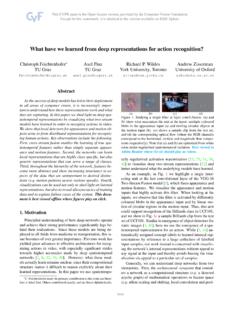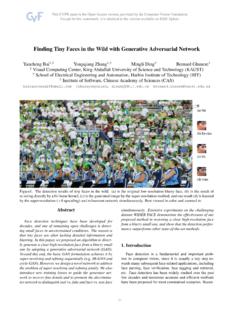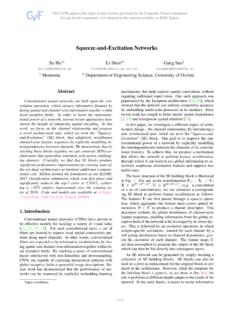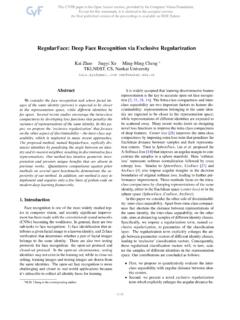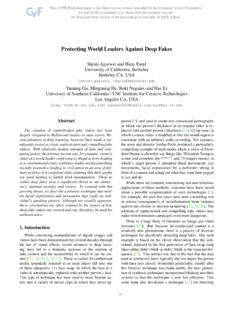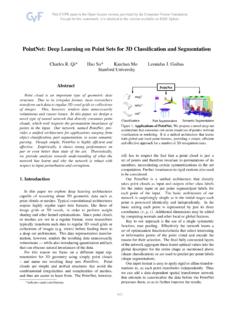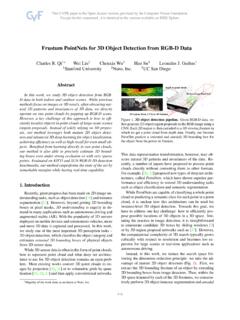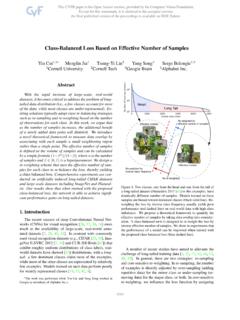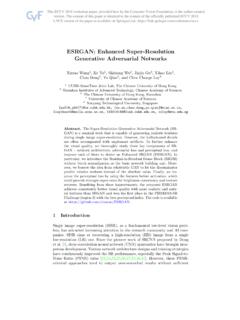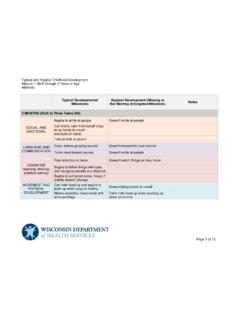Transcription of Self-Supervised Representation Learning From Videos for ...
1 Self-Supervised Representation Learning from Videos for facial Action Unit Detection Yong Li1,2 , Jiabei Zeng1 , Shiguang Shan1,2,3,4 , Xilin Chen1,2. 1. Key Laboratory of Intelligent Information Processing of Chinese Academy of Sciences (CAS), Institute of Computing Technology, CAS, Beijing 100190, China 2. University of Chinese Academy of Sciences, Beijing 100049, China 3. CAS Center for Excellence in Brain Science and Intelligence Technology, Shanghai, 200031, China 4. Peng Cheng Laboratory, Shenzhen, 518055, China { , sgshan, Abstract In this paper, we aim to learn discriminative representa- tion for facial action unit (AU) detection from large amount re-generate of Videos without manual annotations. Inspired by the AU-related AU movements fact that facial actions are the movements of facial mus- feature . AU-changed cles, we depict the movements as the transformation be- tween two face images in different frames and use it as the self-supervisory signal to learn the representations.}
2 How- . ever, under the uncontrolled condition, the transformation source image target image . pose-changed is caused by both facial actions and head motions. To re- pose-related move the influence by head motions, we propose a Twin- movements Cycle Autoencoder (TCAE) that can disentangle the facial re-generate action related movements and the head motion related ones. Speci cally, TCAE is trained to respectively change the fa- Figure 1. Main idea of the proposed Self-Supervised Learning cial actions and head poses of the source face to those of framework Twin-Cycle Autoencoder (TCAE). TCAE learns AU. the target face. Our experiments validate TCAE's capa- discriminative features by predicting the disentangled movements bility of decoupling the movements. Experimental results that change the AUs and head poses respectively. TCAE ensures also demonstrate that the learned Representation is discrim- the quality of the discovered movements by transforming the AU- changed and pose-changed faces back to the source.
3 Inative for AU detection, where TCAE outperforms or is comparable with the state-of-the-art Self-Supervised learn- ing methods and supervised AU detection methods. puter interaction. Recently, the development of AU detection is facilitated by the progress in deep Learning [47, 22, 21, 32]. However, 1. Introduction it is data starved to make full use of these supervised meth- ods, because labelling AUs is time consuming, error prone, facial actions convey varied and nuanced meanings, in- and confusing. It takes 30 minutes or more for an FACS. cluding a person's intentions, affective and physical states. expert to manually code an AU for a one-minute video [46]. To study the facial actions comprehensively, Ekman and To alleviate the demand for adequate and accurate anno- Friesen developed the facial Action Coding System (FACS) tations, we exploit the practically in nite amount of unla- which de nes a unique set of about 40 atomic non- belled Videos to learn discriminative AU representations in overlapping facial muscle actions called Action Units (AUs) a Self-Supervised manner.
4 Considering that AUs appear as [8]. AU detection has drawn signi cant interest from com- the local movements within the face and the movements are puter scientists and psychologists over recent decades, as easy be to detected without manual annotations, we propose it holds promise to an abundance of applications, such as to use the movements as the supervisory signals in Learning affect analysis, mental health assessment, and human com- the AU representations. However, the detected movements 10924. are always caused by both AUs and head motions. In some motions within local regions of the face [13] and thus in- cases, especially in uncontrolled scenarios, head motions troduced sparsity-induced algorithms [45, 34] to reduce the are the dominant contributors to the movements. If we do in uence of uncorrelated facial regions. not remove the movements of head motions from the super- Over the last few years, deep Learning has become a dom- visory signals, the learned features would not be discrimi- inating approach due to their capability and capacity of rep- native enough for AU detection, because they would encode resentation Learning .
5 These methods [47, 22, 21, 32] learn more information about head poses than those about AUs. rich local features to capture facial deformation. For exam- To address the Learning issue from entangled move- ple, Zhao et al. [47] proposed a locally connected convolu- ments, we propose a Twin-Cycle Autoencoder (TCAE) tional layer that learns region-speci c convolutional lters that self-supervisedly learns two embeddings to encode the from sub-areas of the face. JPML [45], EAC-Net [22] and movements of AUs and head motions, respectively. Fig. 1 ROI [21] extracted features around facial landmarks that are illustrates the main idea of the proposed TCAE. We sam- robust with respect to non-rigid shape changes. JAA-Net ple two face images (the source image and the target image) [32] proposed to jointly learn AU detection and face align- of a subject from a video where he/she is talking and mov- ment in a uni ed framework.
6 These methods have achieved ing with varied expressions. TCAE is tasked to change the promising performance on annotated datasets, , CK+. AUs or head poses of the source frame to those of the target [23], DISFA [25], BP4D [42]. However, these methods de- frame by predicting the AU-related and pose-related move- pend on accurately labelled images and often over t on a ments, respectively. Thus, TCAE distills the information re- speci c dataset because of insuf cient training data. quired to compute the AU- or pose-related movements sepa- To alleviate the dependence of AUs annotations, several rately into the corresponding embeddings. During the train- works start to focus on Learning model in a semi-supervised ing, TCAE enforces the generated face images to be realis- [40, 4], weakly-supervised [46, 31, 43] or Self-Supervised tic because their quality implies how well the movement is manner [38].
7 The semi-supervised Learning methods usu- discovered and thus implies how good the Representation is. ally incorporate both labelled and unlabelled data by assum- Since we do not have the real face images that merely AUs ing the faces to be clustered by AUs, or to have a smooth or poses are changed, we introduce a twin-cycle mechanism label space. The weakly supervised methods exploit noisy, to control the quality of the generated face images. In each incomplete AU annotations [46]. They usually learn AU. cycle, either the predicted AU-changed face or the pose- classi ers from domain knowledge [43], or naturally exist- changed face is mapped back to the source. Meanwhile, ing constraints on AUs [31]. We adopt the Self-Supervised the AU-related and pose-related movements are combined Learning paradigm because it can learn AU discriminative to map the source to the target.
8 We show that our proposed features without AU labels and it is regardless of the as- TCAE can disentangle the movements caused by AUs and sumptions on label distribution. head motions. Self-Supervised Learning . Self-Supervised Learning In summary, our contributions are two folds: 1) We pro- adopts supervisory signals that are inferred from the struc- pose a Self-Supervised Learning framework Twin-Cycle Au- ture of the data itself. The signals include image coloriza- toencoder (TCAE) to learn AU representations from un- tion [41], order of a set of frames [26, 18, 11], camera trans- labelled Videos . Experimental results show that TCAE formations between pairs of images [1] etc. A typical self- outperforms or is comparable to the state-of-the-art self- supervised method is SplitBrain [41], which consists of two supervised Learning methods and supervised AU detection sub-nets.
9 For the images, each sub-net predicts a subset of methods. 2) TCAE can successfully disentangle the AU- the channels according the other subset. The features ex- related movements from the pose-related ones. It indicates tracted by the two sub-nets are concatenated and serve as potential applications in editing face images. the generic representations. Since the proposed TCAE is supervised by the disen- 2. Related work tangled AU-related and pose-related movements, we review the related Self-Supervised methods that can adopt the mo- Faction unit detection. AU detection has been studied tion information as the supervisory signal, or can disentan- for decades and various methods have been proposed [24]. gle different factors. To achieve good performance, researchers have designed The former learn visual representations from Videos with different features to represent AU.
10 The features include the the help of motion information, , optical ow [36, 29], appearance texture of the whole face [44] or near the fa- pixelwise correspondence [12], egomotion [17, 1], or ap- cial landmarks [35, 9, 37], or the combination of geometry pearance ow [38, 39]. The most related work to TCAE. shape with texture [10]. Most of these features are based is Fab-Net [38], which is optimized to map a source frame on general features in computer vision task, such as SIFT, to a target frame by predicting a ow eld between them. HOG, LBP, etc. To make the features discriminative for AU, However, the learned embedding of Fab-Net is not a ded- some works considered that AU is tightly correlated to the 10925. Cycle with AU Changed source image AU-related displacements AU-changed image generated Feature Disentangling source image encoder target image AU decoder pose decoder overall source image Target Reconstruction AU feature displacements pose feature elementwise product source image elementwise add generated target target image bilinear sample source image Cycle with pose Changed generated image attention mask generated pose-related source image pose-changed image displacements Figure 2.
